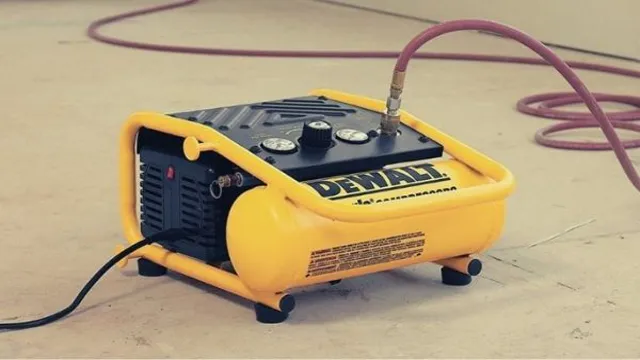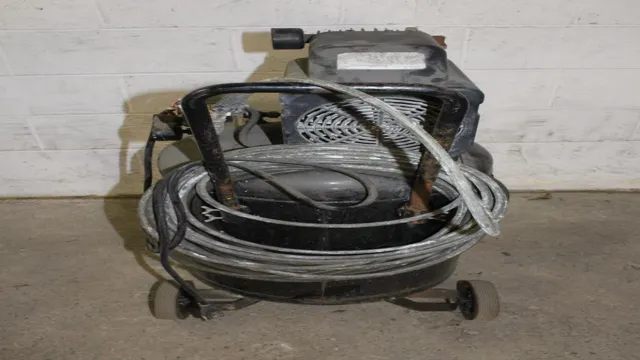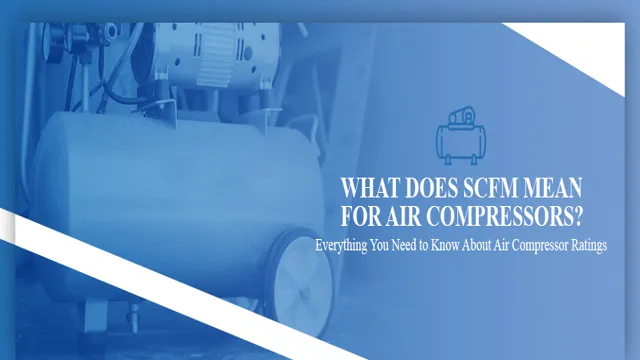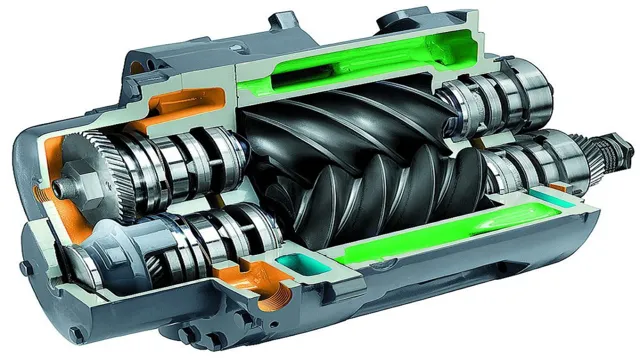How to Connect Air Compressor to Backflow Preventer: Step-by-Step Guide

Are you looking to connect your air compressor to a backflow preventer but aren’t sure where to start? No need to worry, we’ve got you covered! A backflow preventer is a critical component in any plumbing system as it prevents dirty water from flowing back into your clean water supply. Similarly, an air compressor is a valuable tool for powering equipment or inflating tires and other items. However, connecting the two can be confusing, especially if you are unfamiliar with plumbing and air compressor systems.
In this blog, we will guide you through the steps necessary to connect your air compressor to a backflow preventer safely. We will cover the necessary equipment, the steps to follow, and any important safety precautions to keep in mind. With our expert guidance, you’ll be up and running in no time, with your air compressor and backflow preventer functioning together seamlessly.
So sit back, relax, and let us do the heavy lifting for you!
What is a Backflow Preventer?
Connecting an air compressor to a backflow preventer is a simple process as long as you follow the proper steps. A backflow preventer is a device that helps keep your water supply safe by preventing the backflow of contaminated water. Connecting an air compressor to a backflow preventer is necessary for some applications such as cleaning out sprinkler systems.
To start, make sure that your air compressor is equipped with a quick connect fitting that is compatible with the backflow preventer. Next, turn off the main water supply and relieve any remaining pressure in the system. Then, locate the test cocks on your backflow preventer and attach the compressor hose to one of them.
Make sure the other test cock is fully closed before turning on the compressor and letting it run for a few minutes to blow out any remaining water in the system. Finally, turn off the compressor and reconnect the main water supply. Remember to always follow the manufacturer’s instructions and consult a professional if needed.
By following these simple steps, you can easily connect your air compressor to a backflow preventer and keep your water supply safe.
Explanation of Backflow Preventer and Its Importance
A backflow preventer is an important plumbing device that ensures the safety of drinking water by preventing contaminated water from flowing back into the water supply. It works by creating a physical barrier that prevents the reverse flow of water in the pipes. Backflow can occur when there is a sudden drop in water pressure, causing water to flow in the opposite direction.
This can lead to contamination of the clean water supply with harmful chemicals or bacteria. A backflow preventer is therefore an essential component of any plumbing system, and its installation is required by law in many jurisdictions. In addition to protecting public health, a backflow preventer can also help prevent damage to plumbing equipment and reduce the risk of flooding or other water-related damage in the event of a plumbing emergency.
It is important to have your backflow preventer inspected regularly by a qualified plumber to ensure that it is functioning properly and providing the necessary protection. Overall, a backflow preventer is a critical piece of plumbing equipment that helps ensure the safety and purity of our drinking water supply.

Choose the Right Air Compressor
When it comes to connecting an air compressor to a backflow preventer, there are a few key things to keep in mind. First and foremost, it’s important to choose the right air compressor for your needs. You’ll want to consider factors like the size of the area you’ll be working in, the type of tools you’ll be using, and the amount of power you’ll need to get the job done.
Once you’ve chosen the right compressor, you’ll need to make sure that you have the right connectors and hoses to connect it to your backflow preventer. It’s also important to ensure that your backflow preventer is properly installed and maintained to prevent any issues down the line. Overall, connecting your air compressor to a backflow preventer isn’t difficult, but it does require some careful planning and attention to detail to ensure that everything works properly and safely.
Factors to Consider When Choosing an Air Compressor for Backflow Preventers
When selecting an air compressor for backflow preventers, there are several factors to consider. The first thing you must do is determine the size and type of compressor that fits your specific needs. The air compressor’s capacity to provide a consistent and sufficient volume of air is the most important factor.
Several models of air compressors are out there, but not all of them are appropriate for backflow preventers. A piston compressor or a rotary screw compressor is preferred because of their high output and constant pressure required to keep the backflow preventer functioning optimally. The air pressure must be enough to move the diaphragm or piston in the valve effectively, preventing backflow.
Additionally, it is essential to consider the voltage, size, power, and noise level of the air compressor. Choosing the right air compressor will save you money and headaches in the long run. Making sure you select the right compressor for your backflow preventer is crucial, and you should always seek professional advice if you are unsure.
Steps to Connect an Air Compressor to Backflow Preventer
If you’re looking to connect your air compressor to a backflow preventer, there are a few steps you can follow to ensure a safe and effective connection. First, make sure your air compressor is turned off and unplugged before beginning the process. You’ll need to attach a hose from the compressor to the nozzle of the backflow preventer, making sure it is securely fastened.
Next, turn on the compressor and allow it to build up enough pressure to activate the backflow preventer. Finally, test the system to ensure that water is flowing properly and that there are no leaks or other issues. By following these steps, you can be confident that your air compressor and backflow preventer are working together effectively and efficiently.
Step-by-Step Guide to Properly Connect an Air Compressor to Backflow Preventer
Connecting an air compressor to a backflow preventer is a simple process, but it’s crucial to ensure that everything is correctly installed to avoid damaging your air compressor or causing potential backflow. Here are the steps to follow for proper connection. First, make sure that your backflow preventer is installed and working correctly.
Check the valve and its surrounding pipes to ensure that they are in good condition and functioning correctly. Next, turn off the water main to prevent any water from flowing into the system. After turning off the water main, locate the discharge valve on your air compressor and attach a hose to it.
Take the other end of the hose and connect it to the connection point on the backflow preventer. It’s crucial to ensure that the hose is securely fastened to prevent any leaks. Once everything is connected, it’s time to turn on the air compressor and gradually increase the pressure to the backflow preventer.
Check the pressure gauge to make sure that it’s at the required level. If the pressure is too high, it could damage the backflow preventer, so it’s essential to monitor the gauge closely. When you’ve finished using the air compressor, turn off the air valve and disconnect the hose from the backflow preventer.
It’s also crucial to turn on the water main to flush out any residual air or debris. By following these steps, you can connect your air compressor to a backflow preventer safely and effectively.
Safety Precautions to Take During the Connection Process
Connecting an air compressor to a backflow preventer requires following specific steps to ensure safety. Before starting the process, make sure to wear protective gear such as gloves and eyewear. Next, turn off the valve and release any pressure in the compressor.
Attach the hoses of the compressor and backflow preventer properly, ensuring a secure connection. Turn on the compressor and allow it to build pressure before opening the valve. During the process, always keep an eye on the pressure gauge to prevent the compressor from exceeding its limit.
After all the work is done, turn off the compressor and release any remaining pressure in the system. Remember to disconnect the hoses properly and store the equipment in a dry and safe place. By following these simple steps, you can ensure a safe and effective connection between your air compressor and backflow preventer.
Testing the Connection
Connecting an air compressor to a backflow preventer requires careful testing before starting any project. The first step is to ensure that all the necessary equipment is available, including the compressor, backflow preventer, and appropriate hoses and fittings. Once all the components are in place, the next step is to check for leaks by inspecting all the connections for visible leaks and listening for any hissing or air escaping sounds.
After confirming that there are no leaks, it’s time to connect the compressor to the backflow preventer and turn it on. It’s important to verify that the compressor delivers the correct air pressure to the backflow preventer, and that water flows out through the outlet when the valve is opened. If everything is working correctly, the connection is now successfully tested and ready to use.
Remember to always perform regular maintenance and inspections to keep your connection safe, efficient, and properly functioning.
How to Test the Connection Between the Air Compressor and Backflow Preventer
One of the most important steps in maintaining your air compressor system is to test the connection between the air compressor and backflow preventer. This is crucial to ensure the safety and efficiency of your system. To perform the test, you will need to shut off the air supply and remove the discharge line from the backflow preventer.
Then, attach a pressure gauge to the bare outlet of the backflow preventer and restore the air supply. The gauge should read the same pressure as the air compressor gauge. If there is a difference in pressure, it could indicate a leak or blockage in the connection.
It is important to address any issues immediately to prevent damage to your system and to ensure it continues to function at its best. By regularly testing the connection between the air compressor and backflow preventer, you can ensure the safety and longevity of your system and avoid costly repairs in the future.
Conclusion
Connecting an air compressor to a backflow preventer may seem daunting, but with the right tools and knowledge, it’s a breeze. Just remember to always follow the manufacturer’s instructions and ensure proper installation to prevent any unwanted backflow. And who knows, with your newfound plumbing skills, you may even inspire your friends to take up DIY projects – just don’t hold your breath waiting for them to ask for help!”
FAQs
What is an air compressor and how is it used in plumbing?
An air compressor is a device used to power pneumatic tools and equipment in plumbing. It can be used to power backflow preventers, among other things.
What is a backflow preventer and why is it important?
A backflow preventer is a device used to protect against the backflow of contaminated water into the public water supply. This is important because it can prevent the transmission of waterborne diseases.
Can any air compressor be used to power a backflow preventer?
No, it is important to use an air compressor that is specifically designed for plumbing and has the appropriate pressure capability to power the backflow preventer.
How do you connect the air compressor to the backflow preventer?
First, ensure that the air compressor is turned off and disconnected from any power source. Then, connect the air hose to the air compressor and the inlet on the backflow preventer. Turn on the air compressor and adjust the pressure as needed to power the backflow preventer.
What is the recommended pressure for powering a backflow preventer with an air compressor?
The recommended pressure varies depending on the type of backflow preventer being used. It is important to consult the manufacturer’s instructions or a plumbing professional for guidance on the appropriate pressure for your specific backflow preventer.
How often should the backflow preventer be serviced when using an air compressor?
It is important to follow the manufacturer’s recommendations for servicing the backflow preventer. Generally, it should be inspected and tested annually by a certified professional.
Are there any safety precautions to take when using an air compressor with a backflow preventer?
Yes, it is important to wear appropriate personal protective equipment, such as eye protection and hearing protection. Additionally, ensure that the air compressor is properly grounded and do not exceed the recommended pressure for the backflow preventer.







